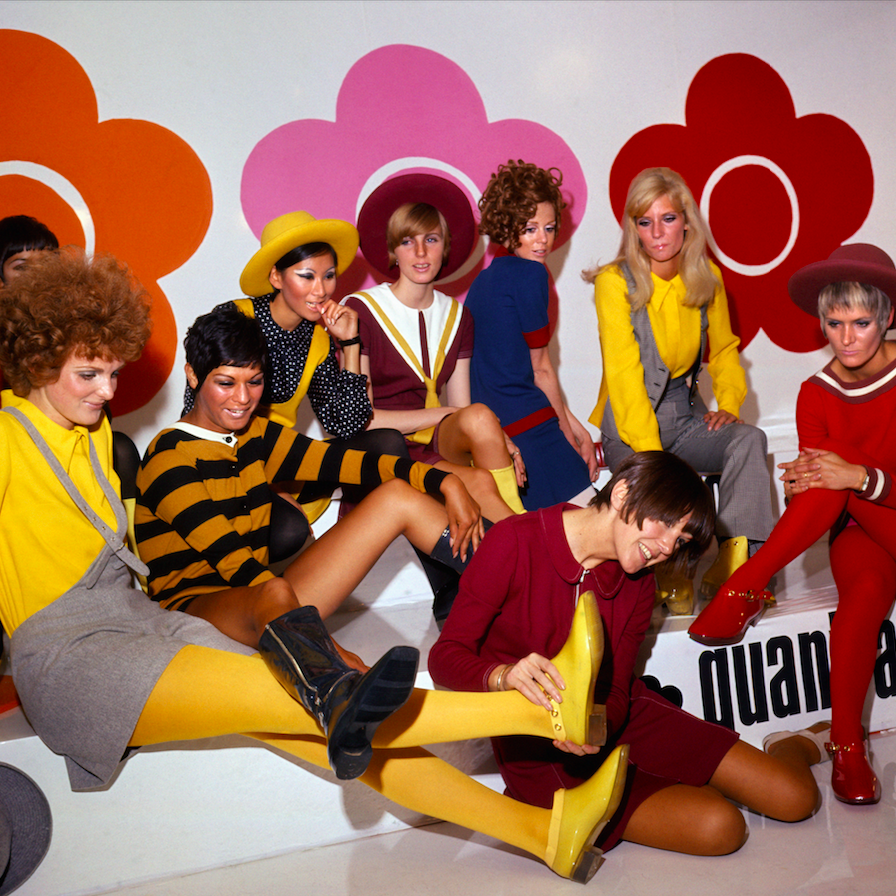The English fashion designer, Mary Quant, holds a significant and unique place in the history of fashion. As the creator of the miniskirt in the early 1960s, she developed a fashion influenced by pop culture and was responsible for the so-called Youthquake. Today, on April 13th, she left us at the age of 93.
But Mary Quant is much more than “the mother of the mini-skirt”, she revolutionised fashion in the Sixties, changing the way young women dressed and looked all over the world. She once said in an interview “Coco Chanel hated me, I can understand why. At that time [in the 1960s], all anyone kept asking her was: ‘What do you think of Mary Quant?’”

The Mary Quant Beauty Bus, 1971 © INTERFOTO Alamy Stock Photo
The Swinging Sixties in London
Mary Quant began her fashion revolution by cutting her grandmother’s skirts shorter, and her hair in a short Bob in the late ’50s. She opened the shop Bazaar on King’s Road, which became the epicentre of the Swinging Sixties in London. Bazaar used to stay open until late with a party-like atmosphere; loud music and drinks, something that no other shop would do in those days. Quant told that the “Kings Road girls invented the miniskirt. I had already made the skirts short, but the customers always wanted them shorter”.
Freedom through clothes and hairstyle
The British designer wanted to give the young working women freedom to move in modern and comfortable clothes. For the first time, girls did not have to wear the same as their mothers. The tight corseted skirt suits from Dior gave way to mini-skirts, baby-doll dresses and tailored pants. Also the perfect hairdos their mothers achieved with the use of rollers and cans of hairspray gave way to the modern bob Vidal Sassoon created for Mary Quant and Twiggy’s pixie haircut. Nothing like this had happened before, nor after. Nowadays, mothers and daughters wear the same clothes. And you basically don’t have teens wanting to express themselves in a radically different fashion.

Mary Quant with Vidal Sassoon, by Ronald Dumont, 1964 @Ronal Dumont/Stringer/Getty Images
And the creator of the miniskirt became a Dame
When young women started wearing Mary Quant’s ultra-short dresses, they shocked many and even received warnings from the police. Still, Queen Elizabeth proved to be much more forward-thinking than you might imagine, by awarded the pioneering designer an OBE (Order of the British Empire) in 1966 for her contributions to the fashion industry. In 2015, Mary Quant was made a Dame Commander of the Order of the British Empire (DBE). She was officially conferred with the title of Dame at an investiture ceremony held at Buckingham Palace on April 17, 2015, by the Prince of Wales.
She also introduced the democratization of luxury
Mary Quant’s eponymous label made clothes more accessible to all by using mass production and new textiles. Quant broke barriers between classes, saying that “snobbery is out of fashion, in our shops, you will find duchesses jostling with typists to buy the same dress”. In the late ‘60s, the designer began using PVC to make knee-high boots and colourful raincoats. She also launched a cosmetic line because she couldn’t find makeup that would suit her modern outfits. Although Mary Quant retired, her makeup brand still exists and is quite popular in Japan.

Mary Quant selecting fabric, 1967 @Rolls Press/Popperfoto/Getty Images
Mary Quant was able to capture the spirit of the times. Young people were rebelling against the establishment, going from the ultra-conservative, monochromatic ‘50s to being at the forefront of a cultural and social revolution in the colourful ’60s. Imagine The Beatles, Pirate radio stations and the iconic Twiggy wearing Mary Quant’s creations.
Interestingly, from the ’60s until today, the discussion about women’s clothes continues the same. Do the clothes you wear define you? Do short and revealing looks give women freedom or objectify them? With the comeback of mini-skirts and the #NoIsNo campaign, Mary Quant is not a nostalgic memory; it is very relevant to what we’re living in 2023.
Images Courtesy from V&A – Mary Quant and models at the Quant Afoot footwear collection launch, 1967 © PA Prints 2008
